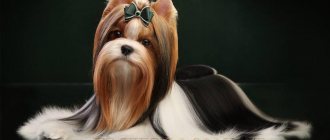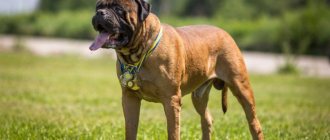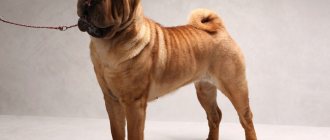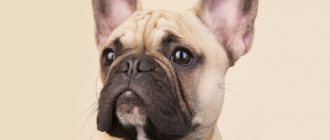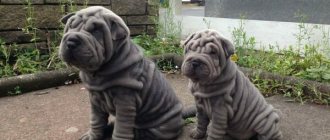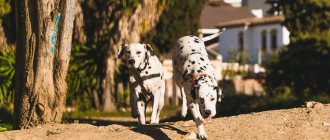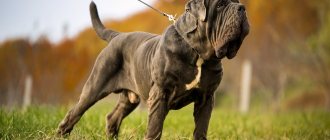Among animal lovers, the most popular breed of dog is the Shar Pei. The history and characteristics of the distribution of the animal are ambiguous.
For many years, Shar Peis, whose origin is associated with China, were quite rare, but over time they began to be of interest in many countries around the world.
History of the Shar Pei breed
There is little information about the origins of the Shar Pei. It is believed that he descended from the smooth-haired chow chow or ancient mastiffs. The blue-black tongue speaks in favor of kinship with the first.
Shar Peis have been known since the Han Dynasty. This is 206 - 220 BC. Proof of this is the findings of archaeologists. In the tombs of III BC. they discovered clay figurines of dogs. These animals have large heads, square bodies and curled tails. In appearance they resemble modern Shar-Peis.
For peasants, the Shar Pei became a universal dog. They were used for protection and hunting. These dogs caught game of any size. They boldly entered into battle with her. Powerful, strong jaws and prickly fur, which was unpleasant to grip, allowed them to emerge victorious from fights with wolves and boars. Dexterity and quick reaction made it possible to catch mongooses that attacked poultry. Ancient Chinese dogs reliably guarded the property of their owners.
Shar Peis were used for entertainment as fighting dogs. However, they did not make good fighters. The dog’s peaceful nature resisted bloody “entertainment.” In order to awaken aggression, tournament organizers gave Shar-Peis special herbal infusions. Only then did fighters with folds show what they were capable of.
At such tournaments, the nobility drew attention to peasant dogs. Soon Shar Peis settled in the houses of nobles, in the imperial palace, and in temples. The owners saw them as an expensive item that could generate income.
In those days, Shar Peis had different dimensions. They were much larger. Their weight was about 80 kilograms.
The situation changed in the 14th century. The reign of the Ming Dynasty (1368 – 1644) went down in Chinese history as a period of famine and war. Objective reasons led to the decline of the breed.
In the 20th century, Shar Peis were on the verge of extinction. In the 40s, the Communist Party came to power in the country. During the socio-political reorganization of the country, its leaders made many excesses. In particular, all pets were considered bourgeois luxury. All dog owners were heavily taxed. The fight against dog breeders did not end there. Mao Zedong later signed a law declaring pets to be useless and harmful creatures. Sharpeyev ordered to be destroyed because of their fighting past. The fight against their smaller brothers led to the fact that by 1970 there were only a few Shar Peis left in China.
The world would never have known about the existence of the Han dog breed if its defenders had not been found in the country. Risking their lives, they transported Shar Peis to Hong Kong, and from there to other countries.
In 1966, Shar Peis came to the United States. There they were given a new name: “Chinese fighting dogs.” In 1978 they were included in the Guinness Book of Records. They were recognized as the rarest and most exotic breed. From America, Han dogs went to Europe. In 1990 they appeared in Russia.
Who is the dog suitable for and where should it be kept?
At first glance, Shar Peis are cute and slow dogs with an intelligent look. After the first meeting, they reveal their character. It has a diverse palette of emotions, causing contradictory behavior . A calm walk can turn into a confrontation with a large dog of the same sex if the opponent shows persistence or signs of aggression. This reason and stubbornness suggest the presence of courage and the ability to stick to one's line in the potential owner.
Shar Peis are not a good choice for children, older adults or teenagers. This breed is not popular in sports, so its representatives are suitable for adults with experience in breeding dogs of serious breeds or other Molossians .
Animals that are smaller in size are not noticed by the Shar Pei. Those living in the same house with them are considered members of their pack or an object of protection. This breed behaves affectionately with children After getting used to it, they enjoy playing with them and looking for adventures.
Watchdog abilities are present in the breed. Shar Peis bark at the door after a bell or knock, and sense a person approaching it. They always monitor the situation and, sensing danger or suspicious things, show a lightning-fast reaction. There are individuals with the ability to detain.
Types of Shar Peis
Enthusiastic breeders began to restore the breed. There were few Shar Peis. The first matings involved dogs of various types. To preserve the exterior it was necessary to resort to inbreeding.
Breeders in different parts of the world not only restored the number of dogs, but also sought to improve the breed and bring their own to it.
During breeding work, the Shar Pei was supplemented with the blood of a chow chow, bull terrier, bullmastiff, boxer and bulldog.
Experts believe that modern Shar-Peis are more like temple figurines than true ancient dogs. The historical type had lighter bones and longer legs. The muzzle was drier and longer. Only the fur remained unchanged - prickly and short.
Now, along with the Chinese, there are other types of Shar Pei: American, English, Mini Pei and Bear. Each of them has its own advantages and disadvantages, supporters and opponents.
Chinese
Classical. The most popular. Dogs have a thick skin and seven folds.
American Shar Pei
The American type Shar Pei is significantly larger in size than the Chinese type. It has an elongated head shape and fewer folds on the body. For this reason he is called the “shar pei without folds.” The coat color is monochrome or black.
European or English
It differs from the Chinese character. Calm and non-aggressive. The trouble is that he paid for improving his character with working qualities. The European Shar Pei is not capable of guarding and protecting.
Mini Pei or Dwarf Shar Pei
The name speaks for itself. Differs from other types in dimensions. Height at the withers does not exceed 43 cm.
Mini Shar Pei is a tribute to the fashion for small dog breeds. Taking into account the tastes of people, breeders sought to obtain miniature-sized dogs. Then they consolidated the result. The formation of this breed is not complete. The Mini Shar Pei is not officially recognized.
Bear
Long-haired Shar Pei. Outwardly it resembles a bear cub. Officially unrecognized. Long hair is a deviation from the breed standard. Despite this, the fluffy Shar Pei is popular among dog lovers.
Interesting Facts
- The poetic inhabitants of Ancient China claimed that the Shar Pei once licked the sky, which is why its tongue was blue.
- The inhabitants of the Middle Kingdom are superstitious, so the dark color of the tongue and palate of the Shar Pei seems to them to be a sufficient reason to claim that such dogs are capable of driving out evil spirits.
- American breeders, working to restore the breed in the 1970s, were able to find only ten individuals throughout China. It was these dogs that gave rise to modern Shar-Peis.
- The French are connoisseurs of this breed of dog, and their sense of humor has led to the adage: “If you take a Shar Pei with you to a meeting with friends, don’t be surprised if you go unnoticed.”
Description of the Shar Pei breed
An independent and reserved dog. Her advantage and disadvantage is that she knows how to think and make decisions.
The character of the Shar Pei is calm and independent. Unobtrusive and unfussy.
Needs a reputable owner. If the owner is weak, he will challenge his role “in the pack.” Will try to take the role of leader.
An adult Shar Pei subtly senses the mood and state of its owner. Has the ability to relieve stress and improve the microclimate in the family. For this reason, Chinese doctors recommend that people suffering from heart disease, hypertension and hypotension, as well as unbalanced temperament, own dogs of this breed.
The Chinese Shar Pei is devoted to his family and his home. However, he is restrained in expressing his feelings. He will never hang around his owner's feet when he returns home. He'll just bury his face in his knee. He will let you know that he misses you.
Shar Peis were bred to be versatile dogs. That's what they are. Good hunters, watchmen and shepherds. Moreover, in order to discover these abilities, they do not need to be specially coached and trained. Skills are in their blood.
Due to the folds on the muzzle, Han dogs have poor vision. Poor eyesight does not prevent them from maintaining control over family property.
Shar Peis are not very prone to pampering and never damage their owner's property. They bark rarely and only for business reasons - they notify the owner of danger.
The fearless dog is not only a good guard, but also a protector. At the right moment, it will always repel the threat that hangs over the owner or family members. Most often it does not bite the enemy, but pins it to the ground. Shar Peis are thinking creatures, capable of independently assessing the situation and taking adequate measures.
Patient and reserved. Agile and fast. These qualities are especially evident during hunting. Most Shar Pei owners are not hunters. They are surprised to discover that their dogs are better than cats at catching mice and small animals.
Herding instincts manifest themselves when a large family goes into nature. The dogs watch carefully to ensure that no one strays from the pack. They try to slightly “gather” family members. This makes it easier to protect them.
Everyone who is not part of the family’s close social circle is treated with caution.
Shar Pei owners claim that with the appearance of a pet in the house, the number of failures, illnesses and troubles in their lives has become less.
Pros and cons of the breed
If you decide to become the owner of a plush pet, it is better to familiarize yourself with all the advantages and disadvantages in advance.
Pros:
- Memorable appearance.
- Many possible colors.
- Peacefulness and kindness towards “our own people”.
- Unconditional devotion.
- Sharp mind and learning ability.
- Suitable for keeping in an apartment.
- It does not require special care.
- Calm.
- Performing security and watchdog functions.
- Good attitude towards children if the acquaintance took place in puppyhood.
Minuses:
- Jealousy and tendency to remember grievances.
- Tendency to a large number of diseases.
- A “steady hand” is needed, otherwise the dog will become uncontrollable.
- Slowness when following commands: the dog first decides whether it makes sense to do something.
- Tendency to food allergies.
- The folds on the muzzle narrow the view, so sudden movements can lead to either fear or aggression.
- Relationships with other pets will most likely not work out.
Shar Pei appearance
The Shar Pei is a stocky, square dog. Medium size. Compactly built, moderately muscular. A distinctive feature is that the dog’s head and withers are covered with skin folds. Height at withers – 44 to 51 cm. Males are larger than females. Male weight: 25 – 35 kg. Shar Pei girls are lighter. Their weight ranges from 18 to 25 kg.
Head
Large. Skin folds on the muzzle and forming a dewlap on the neck visually increase its size. As a result, the head appears larger than the body. It is wide and flat. Thanks to the same folds on the forehead and around the eyes, the dog looks unfriendly and sad. The muzzle is wide and strong, not tapering towards the nose.
Ears
Small and fat. They have the shape of a triangle. High-set, with rounded tips that hang down to the eyes.
Eyes
Almond-shaped. Medium size. Mostly brown. Dogs of dilute colors can have light eyes. It is important that folds and fur on the face do not cause irritation to the mucous membranes of the eyes.
Mouth
The jaws are powerful. Scissor bite. The tongue is blue-black.
Neck
Powerful, medium size. A little excess skin is allowed on it. However, it should not form folds around the ears and shoulders.
Frame
The back is strong. The loin is short. There should be no folds on the body of an adult Shar Pei. The exception is the areas of the withers and base of the tail. A small number of “wrinkles” are allowed there. Puppies have many folds on their body, but with age they straighten out. The height from the withers to the ground should coincide with the length from the withers to the buttocks.
Rib cage
Deep. Dropped to the elbows.
Tail
Set high. Thick at the base, tapering towards the tip. Twisted into a ring.
Limbs
The paws are compact and strong. Exactly placed. Muscular. It is desirable that there are no folds on them.
Wool
Has no undercoat. Consists of guard hairs. Rude. It feels like horsehair to the touch. Breeders divide it into three types: horse, brush and bear. Depending on the type, the length of the hairs ranges from 1 to 2.5 cm.
Initially, the breed was characterized by horse hair. Short and prickly. The length of the hairs is less than 1 cm. Horse hair causes skin irritation in many people. In China, only this type of wool is recognized as correct.
The length of brush wool is 1 – 2.5 cm. It feels a little softer than horse wool, but retains its rigidity and does not adhere to the body. Brush Shar-Peis look more massive than their horse counterparts.
Color
Solid. Tan and stains are not allowed. Darker shades are allowed on the back along the spine and on the ears, lighter shades on the tail and back of the thighs.
Colors are divided into two types - basic or saturated and diluted - blurred. The classification is based on the presence of black pigment in the color.
Rich or basic. With this color, the dogs have a dark mask on their muzzle. It can have different types: from gray coating to solid black. This group includes the following colors: black, red, blue, cream, isabella, sable and fawn.
Diluted or unsaturated. Animal fur has shades: cream, chocolate; blue, ash, smoky, red, red, apricot, isabella, lilac and sable.
Main types of colors
The standard states that the color of the Shar Pei can be any solid color except white. Experts distinguish two types of color: basic and diluted (weakened). The main colors have a black pigment; these dogs usually have black pigmentation on the face. Dilute colors - without the presence of black.
- Basic : black, red, fawn, cream, blue, isabella, sable.
- Diluted : chocolate, red, cream, apricot, isabella, lilac, sable.
Photo of Shar Pei
Education and training
It is necessary to raise a puppy from the first days of its appearance in the house. The child needs to immediately define the boundaries of what is permitted. You should not indulge his pranks and desires. Otherwise, you will soon regret it. When you try to discipline an adult dog, she will perceive this as an infringement of her interests.
From the first days, the puppy must understand that he is not the boss in the house, but the owner.
Shar Peis require early socialization. It is important to teach them to react calmly to unfamiliar people and animals.
Teaching a Shar Pei commands is not an easy task. A number of trainers refuse to take them into groups. There is an opinion that they are not trainable. This is wrong. Han dogs are highly intelligent. But at the genetic level, they have independence in decision-making.
At a time when a bad trainer loses his temper trying to force his pet to carry out a command, the Shar Pei is trying to find answers to the questions - is it really necessary to do what the owner requires and why is it necessary.
It is better to teach a Shar Pei commands in a game, like a child. Use this method! You will be surprised how quickly your pet will master everything.
Shar-Peis should not be yelled at or hit. They won't understand it and won't forgive it. Lock yourself in. They will stop responding to commands. With a rude attitude, an inexperienced owner can completely undermine the dog’s trust.
In order for a “Chinese” to be obedient and well-mannered, you need to be patient. Pay attention to him every day, achieve obedience and impeccable execution of commands.
Temperament and character
Positive traits:
- Equilibrium.
- Self confidence.
- Silence.
- Smartness.
- Devotion.
- Activity.
- Independence.
Negative qualities:
- Stubbornness.
- Cockiness.
- They study for a long time.
- Prone to escape.
- Requires control.
They should not have aggression, but sharpeis often sort things out with large opponents.
Care and maintenance
It doesn't take much effort to make your gloomy pet look well-groomed.
Hair and body care
You need to brush your dog 1-2 times a week with a short brush or a special mitt. During molting period daily. This period in Shar-Peis often passes unnoticed by the owners. Sometimes pets develop unsightly bald spots. They usually quickly become overgrown with new fur. If the process takes longer, consult your veterinarian. Perhaps the dog lacks vitamins.
Animal skin needs special care. You should periodically wipe the dog's skin folds. Dirt, gland secretions, and food debris accumulate in them. If redness appears in the skin folds, sprinkle with baby powder. Improper care can cause dermatitis in your pet.
You should monitor the condition of your eyes and ears. If your eyes are red, watery, or have discharge, wipe your eyes with a swab moistened with a special lotion. If it doesn't help, contact your veterinarian. The cause may be an allergy or an infection. Wax and dirt should be removed from your ears regularly.
The dog should not be washed more than 3-4 times a year. Shar Peis do not like water treatments. If your pet gets dirty, wipe it with a damp towel. Han dogs are clean and have no odor.
Nails need to be trimmed regularly. You can do this yourself with a nail clipper. Or visit a pet salon.
Walks
Dogs need walks to stay physically fit and healthy. Their duration should be at least 1.5 - 2 hours a day. Intense loads are harmful to them due to the structure of the respiratory tract. It is better to walk with such a dog at a walk.
Feeding
The owner decides what to feed the Shar Pei. This can be industrial food or a natural diet.
If you choose the first option, give preference to premium or super-premium dry food. For dogs with allergies, choose food based on lamb or fish.
A natural diet should be based on 2 types of cereals: rice and buckwheat. Rice should predominate. Porridge should be cooked in water, not broth. It is recommended to add boiled fish or meat to them - turkey, rabbit, lean lamb or beef. If your pet is not allergic, you can include boiled or grated vegetables in your diet: cabbage, zucchini, carrots. Expand your diet with fermented milk products. Include an egg once a week.
The Shar Pei should always have access to fresh and clean water.
Shar Pei health
Shar Pei is an ancient breed of dog. Must be in good health. In fact, this breed is doing so poorly that many canine organizations doubt the advisability of its further breeding.
The reason for the degradation of the breed is closely related to historical events. In the 20th century, almost all Shar Peis were exterminated in China. They restored the breed from individuals that had managed to be brought abroad. There were few dogs. Breeders often resorted to inbreeding - mating close relatives.
Modern experts are trying to restore the breed. Dogs with genetic disorders are removed from breeding. However, the situation is such that even conscientious breeders cannot guarantee buyers that the puppies will grow up healthy.
Breed diseases
Kidney failure
There are no lines of Shar Peis that are free from this disease. Most pets die from this disease. Some live 10 years, others 3–4 years. It is impossible to predict how long a dog will live. This largely depends on luck.
Shar Pei fever
It is also hereditary. The temperature rises, joints swell, abdominal pain, vomiting and diarrhea appear. There are no effective treatments.
Hypothyroidism
Dogs do not produce thyroid hormones. This leads to severe changes in the body. Epilepsy develops. Skin and coat problems appear.
Dysplasia
Degenerative joint disease.
Gastric volvulus
A sharp enlargement of the stomach and twisting around the esophagus. The cause may be air entering the dog's stomach during rapid absorption of food. Sudden movement of the pet after a hearty meal. If this happens, the dog must be quickly taken to a veterinary clinic for surgery. Delay will result in death.
Glaucoma
An eye disease caused by increased intraocular pressure. Leads to loss of vision.
Entropion
The eyelid turns toward the eyeball and injures the cornea. If help is not provided in time, it can lead to loss of vision.
Questions about the breed
How is "Shar Pei" translated from Chinese?
The name of the dog breed literally translates as sandy “hair”. The word "ball" means granular sand.
The Chinese Shar Pei has a really spiky coat. She protects him from the bites of opponents. In humans, it can cause skin irritation or contact dermatitis.
Why Shar Peis are called ancient dogs
The Shar Pei belongs to the first cluster of dog breeds. His genotype and that of the wolf are as close to each other as possible. This confirms that the Chinese dog breed was one of the first to be formed. It hasn't changed much since then.
Along with the Shar Pei, 13 more dog breeds belong to the first cluster. Among them are Akito Inu, Alaskan Malamute, and Basenji.
Fighting dog or not
In the United States, Shar Peis have been registered as the "Chinese Fighting Dog". This is an incorrect name. Shar Pei is a versatile dog. In their homeland, for centuries they were used primarily for property protection, hunting and as shepherds. At the same time, they pitted each other against each other for fun.
How do Shar Peis treat children?
There is no clear answer to this question. It all depends on the character of your pet. Some owners do not recommend taking representatives of this breed into families with children. Others claim that Shar Peis love children. They can play with them for hours. They tolerate all their liberties and pranks that would never be tolerated from adults.
How does a Shar Pei treat other pets?
It is difficult to get along with other pets. The exceptions are dogs and cats with whom he became friends in childhood. Indifferent to the rest. May show aggression.
Why does Shar Pei have folds?
In 2010, scientists from the University of Washington conducted a study of Shar Pei dogs. They were interested in the reason for the formation of skin folds in them. The researchers concluded that the reason was a mutation in the HAS2 gene, which is responsible for the formation of skin cells. Researchers believe that a glitch in the dogs' DNA led to the birth of puppies with folds. Ancient Chinese breeders appreciated the unusual appearance and secured it in the breed.
Fighting dog or not
One of the common questions that arises among people who read the history of the breed. Participation in dog fighting is a thing of the distant past. The dogs managed to retrain as hunters and watchmen, and the intervention of breeders finally freed the Shar-Peis from their bitterness.
The hot temper and hostility towards strangers are the result of security, not fighting functions. Therefore, despite the name “Chinese Fighting Dog” registered in the USA, modern Shar Peis are not suitable for the role of a fighter in the ring.
Photos of puppies
How to choose a Shar Pei puppy
Before choosing a puppy, get to know its parents. Ask about the baby’s relatives: grandparents, great-grandparents. If they are alive and well, that's a good sign. The hope is that your dog will not develop severe hereditary diseases.
Pay attention to the appearance and condition of the mother. In many ways, the health of puppies depends on the conditions of keeping and nutrition of the bitch during pregnancy.
The best age for moving a puppy to a new home is 2.5 months. The baby can already do without his mother’s care. His character is not formed. The owner will be able to influence its development.
Decide what gender of pet you want. The Shar Pei girl is more flexible, she feels and understands her owners more subtly. The boy is more active and assertive. It is larger in size, so it looks more impressive.
Kids should be cheerful and cheerful. They should not shy away from sudden movements and cower in corners. If this happens, most likely they are kept indoors and are not educated.
Examine the puppy before purchasing. There should be no dried crusts around the eyes and nose. The eyes should be open and there should be no clouding on the cornea.
Look into the mouth. The baby's tongue should be blue or lavender. But not pink.
There should be no dewclaws on the hind legs. If puppies are born with them, the breeder is required to remove them.
Pay attention to the puppy's coat. It should have an even color. The length of the coat should not exceed 2.5 cm.
The most important thing is that you must like the Shar Pei puppy. You must be aware that by purchasing it you are taking responsibility.
Photo gallery
Photo 1. Adult Blue Shar Pei with his puppy
Photo 2. Shar Pei in chocolate color
Photo 3. Puppies with a heart

